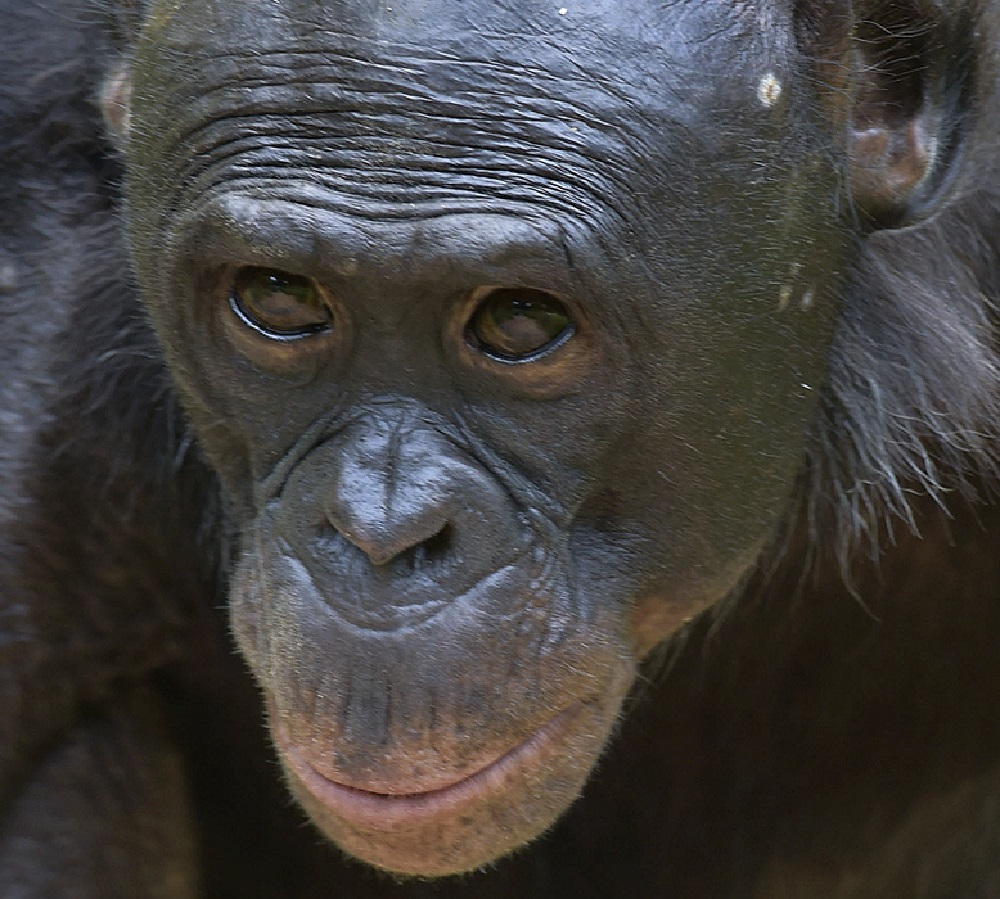bonobo Facts
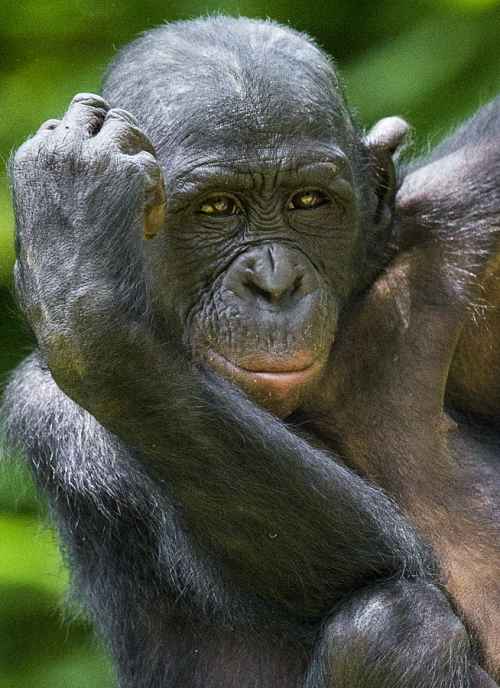 Portrait of a Bonobo
Portrait of a BonoboOne of the most fascinating bonobo facts is that the bonobo uses sexual contact to diffuse conflicts rather than resorting to violence. The bonobo and the chimpanzee are in the same genus and were considered the same species until the 1920's.
Originally the bonobo was called the "pygmy chimpanzee", and is sometimes still referred to by that name. The average size for a bonobo is about 3 1/2 feet tall and 65 to 80 pounds, although males can be as heavy as 150 pounds. The largest male chimps top 200 pounds, but overall, the size difference between the two species is not that significant, and in the mid 1950's the "pygmy" term was largely discarded and replaced with the name "bonobo".
Physical differences between chimps and bonobos are not obvious. Chimps tend to be bulkier with shorter limbs and more pronounced muzzles. The bonobo usually has pink or red lips and black skin on the face, which is seen in juveniles as well, while juvenile chimps will have light colored faces, and may retain a lighter skin tone as adults, though adult coloration varies.
Bonobos in the wild generally have full heads of black hair parted oddly right down the middle, but in captivity many bonobos are bald. The balding occurs presumably through excessive mutual grooming. One theory is that troops in the wild have more members so the grooming is spread around, but that idea does not stand up to simple logic - wouldn't more members mean more individuals not just to groom, but to be groomed by? Boredom, stress, or other environmental factors are far more likely the cause.
The word "bonobo" may be a misspelling of the village of Bolobo, located in the heart of bonobo territory in the Democratic Republic of the Congo (DRC). This one country in Central Africa is where all wild bonobos live. Their entire population in the wild is unknown, but is believed to number between 30,000 and 50,000 individuals. The Democratic Republic of the Congo is plagued by civil unrest, and the government is not currently able to protect the population from poaching and deforestation. Bonobos are currently considered endangered, and may be extinct in the wild within 30 years if their situation does not improve.
Bonobos are highly intelligent, extremely social great apes. They live in very cooperative and peaceful groups, known as troops, with as many as 70 members, but 15 to 30 is most common. Their fluid social structure is known as fission-fusion, which means they may come together in various sized groups, or separate for different activities, different times of year, and depending on who is available to "hang out" with. Just as we do.
They are omnivorous, eating a large variety of fruits and plant stuffs, as well as small animals and fish. Like chimps, they will hunt together in groups, sneaking up on and cornering monkeys, reptiles and young antelope.
Bonobos live in deep forest and swamplands in an unstable region of the world, so there was little study of them in the wild when they were first discovered. Some of what was known about them, however, so confused and disturbed the scientific community that it was kept secret for decades.
The fact is, the bonobo has a social structure that incorporates regular and very casual sexual contact between all members, that has nothing to do with reproduction.
Although some of this contact is clearly just for fun, much of it is a social skill used to avoid conflict, reassure one another, and build bonds. The result is a society with very little violence, and where lethal aggression and infanticide - quite common in chimps and human beings, is virtually unheard of.
So is violence simply in the genes of certain species?
Well, when researchers sequenced the genome of the chimpanzee in 2005 and the bonobo in 2012, they found that they still share 99.6% of their DNA, while human beings share about 98.7% of our DNA with both chimps and bonobos, suggesting that something other than genetic makeup.
Humans and bonobos share one thing that chimps do not possess - a pattern in the brain cells called spindle cells or Von Economo Neurons. This is a pattern associated with empathy and other complex social skills, that is also found in whales and elephants - fascinating bonobo facts.

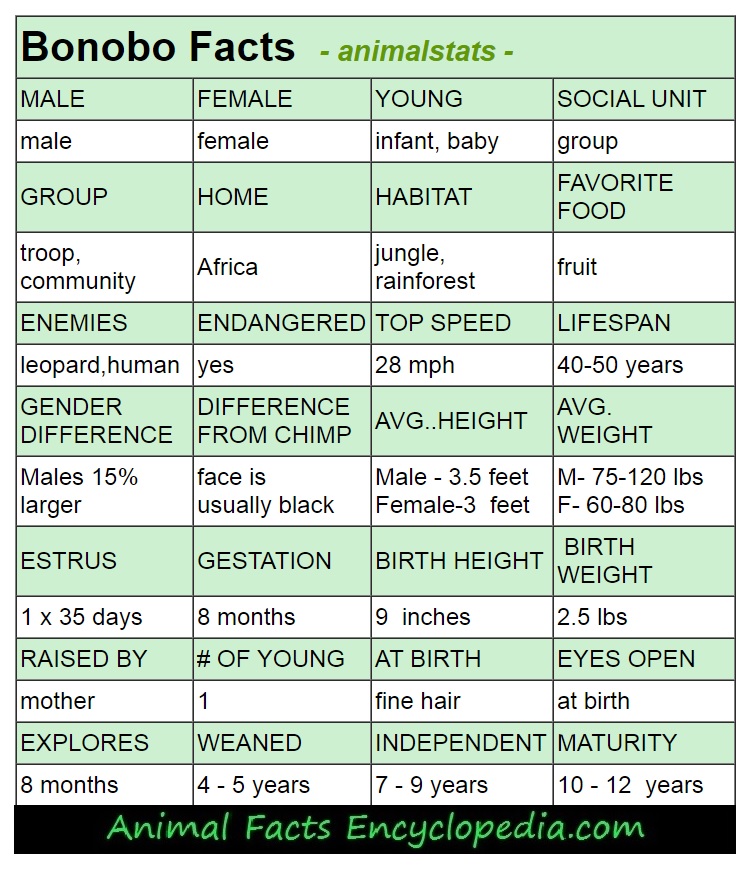

bonobo sex life
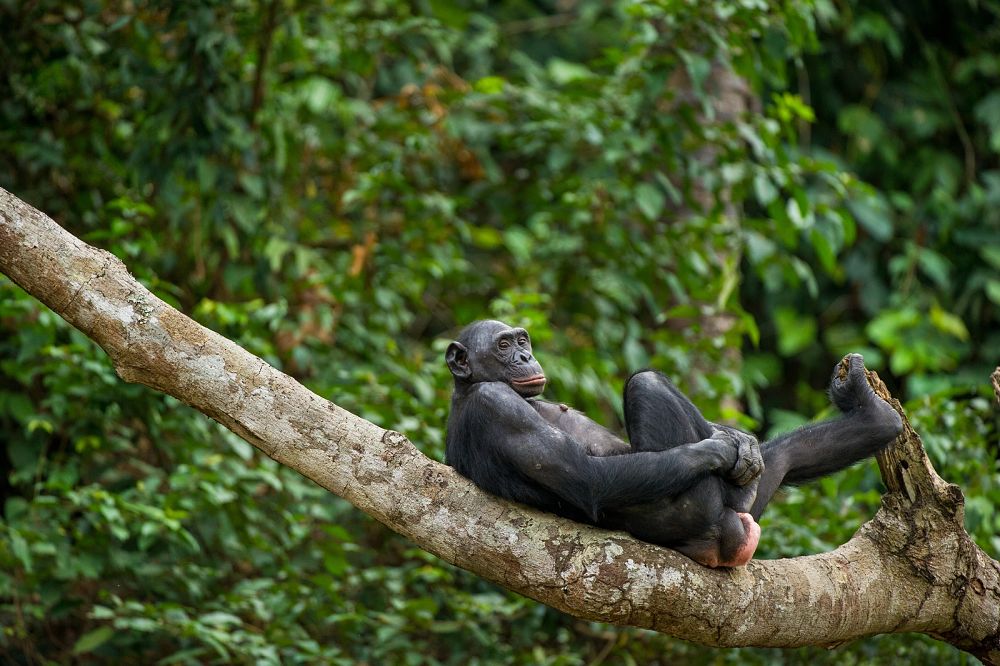
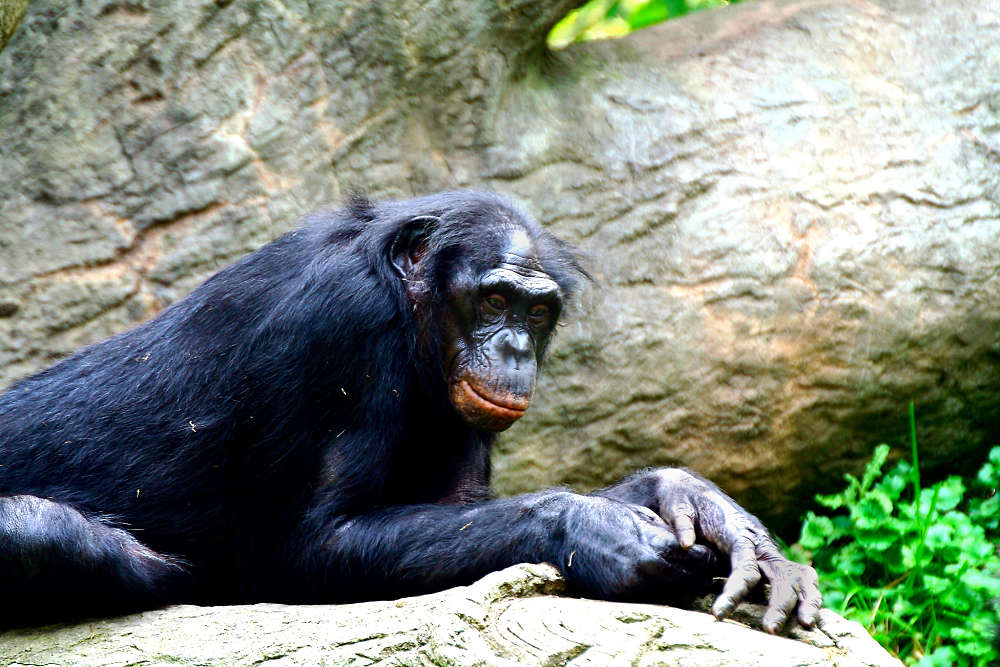
Many people in Religious and scientific circles have erroneously contended that human beings are alone in the pursuit of sexual activity purely for pleasure, and although many animals, (and birds) engage in what appears to be recreational sex, the bonobo snuffs that myth with abandon.
Bonobos engage in orgies, homosexuality, and masturbation, not necessarily in that order and certainly not to the exclusion of any one activity. It is exceedingly casual, comforting, usually very fleeting and apparently quite pleasurable.
One of the hallmarks of Christian civilization was the idea that humans were the only land animals to have intercourse face to face. In fact, teaching this position to other communities they encountered was one of the goals of Christian missionaries, and is the reason why we call it the "missionary position."
But bonobos copulate face to face all the time.
This fact, and the shear frequency of the sexual contact caused the scientific community to keep details about the bonobo lifestyle a secret for decades, and wasn't openly discussed until the 1970's.
The sexual contact among bonobos serves many purposes and is critical to their community. Often it is an expression of excitement in a situation that might cause aggression in other species.
While dominant male chimps will put on angry, sometimes violent displays to keep subordinates away from new found food, bonobos will celebrate the discovery of food as a group by touching and rubbing against each other before settling down to eat.
In fact, most situations that might cause other creatures to become violent, such as accidentally stepping on a sleeping neighbor, are greeted with sexual contact by bonobos.
Ultimately, it is a system that works, and they are largely peaceful animals.
female dominance in bonobo society
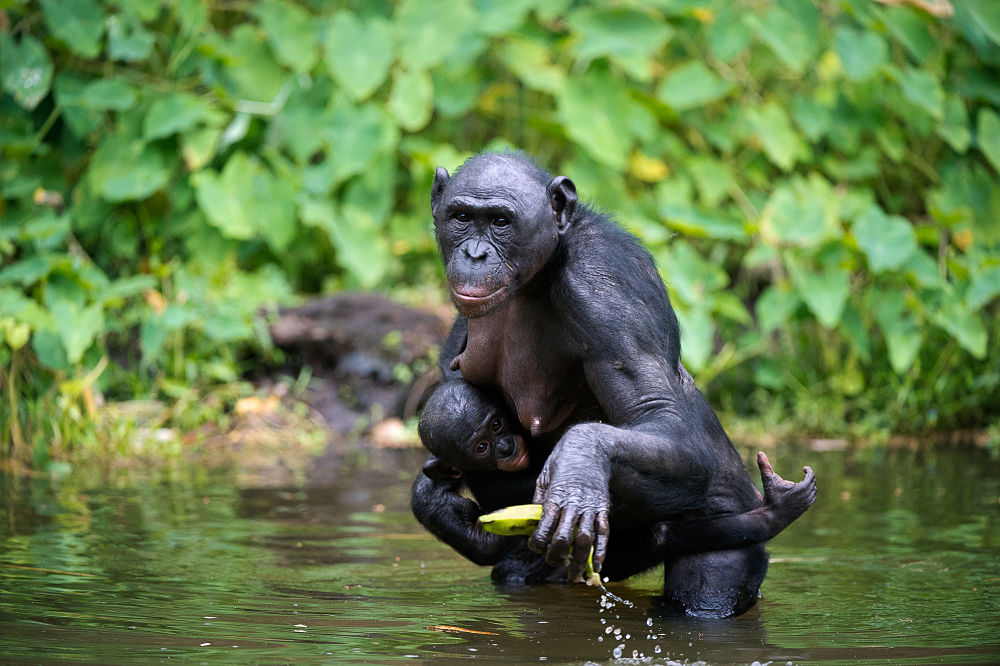
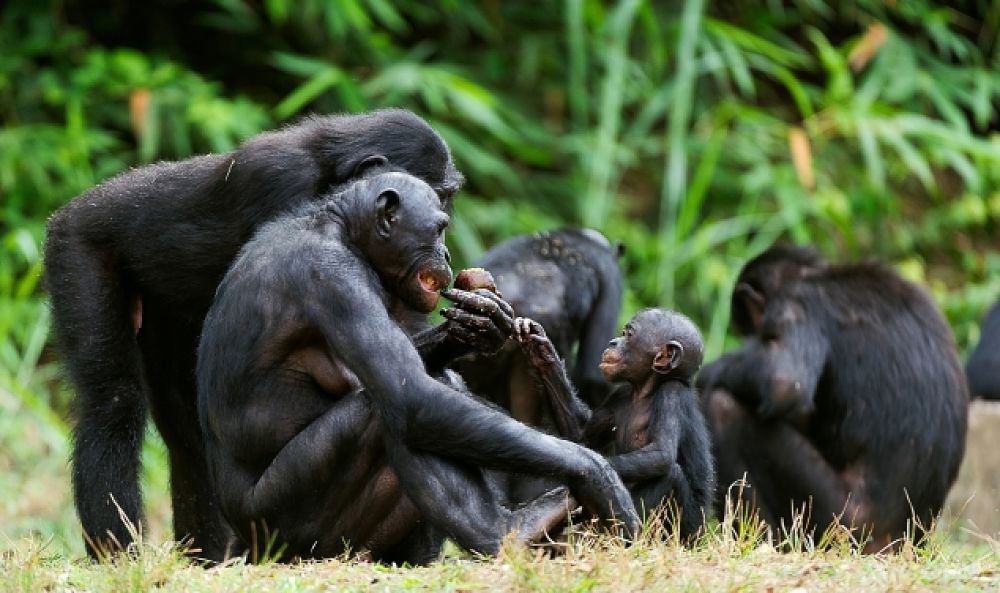
Between 4 and 8 million years ago, our ancestors began to evolve separately from those of chimps and bonobos. Then, when the Congo river was formed one million years ago, the chimp population was split geographically. Chimpanzees continued to develop north of the river, and bonobos evolved to the south.
The southern landscape was rich in resources, a lush, tropical world, that may ultimately have required less adaptions for continued survival. The bonobo is physiologically less specialized than the chimpanzee, and may be closer to what our common ancestors really looked like.
More importantly for the present-day animal, it's nurturing environment may have allowed it to remain more peaceful, with less competition, and may have allowed the females to become the leaders and rule-makers.
Bonobos have a matriarchal society where females dominate and make most of the decisions as far as group activities. Like chimpanzees, males generally stay with family groups for life, while female bonobos are the ones that may set off on their own to join a new family, or form a new troop. As a result, most of the adult females in a bonobo community are unrelated.
But how the female bonobo attains acceptance and status in that new group is vastly different from how the female chimp gains favor. And is one of the many significant differences between chimps and bonobos.
A young female chimp gains favor by submitting to dominant males. A young female bonobo finds acceptance by pandering to the dominant females in her new group. And she will use sexual contact in the form of genital touching, to win them over.
Female bonobos even regularly lay with eachother in the missionary position and rub their genitals together, often quite energetically and joyfully.
The relationships that these non-related females form is very unique in the animal world, and is one of the other fascinating things we have in common with them. These adult bonobo females, who are usually unrelated because they relocate to new groups, actually form tighter bonds than do the males in the group, many of whom are assumed to be related, because they all remain in the group their whole lives.
Ultimately, female bonobos run things by teaming up. Males may be as much as 25% larger, but they don't develop the close bonds that females do, and they don't work together. The females come to eachothers aid against aggressive males, stick together, and dominate by acting as a gang.
Male bonobos generally concede to females, wait for them to eat first, give up favorite sunning spots, simply move out of the way. If they don't, they may be on the receiving end of some of the only violent acts that occur in the bonobo community. Groups of female bonobos will occasionally attack males, and have been known, in particular, to actually bite off their fingers or toes.
This behaviour has been witnessed infrequently in the wild, but unfortunately seems to increase in captivity. Stress and overcrowding is probably the cause of the increase, but nevertheless, the bonobo is definitely capable of violence, and it is usually the females who inflict the most damage. - Bonobo Facts

are bonobos smarter than chimps?
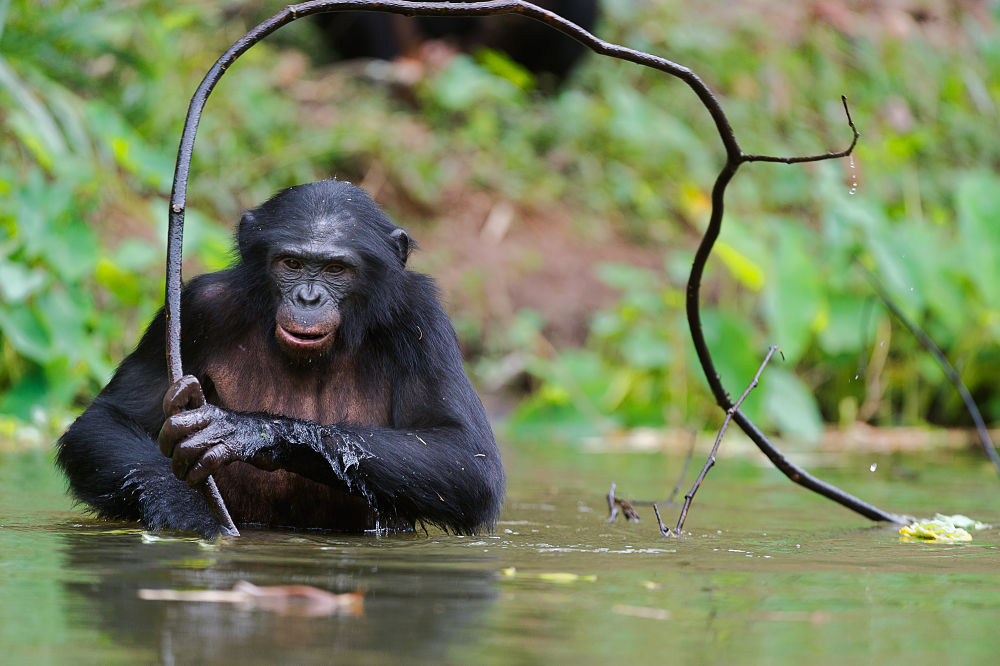
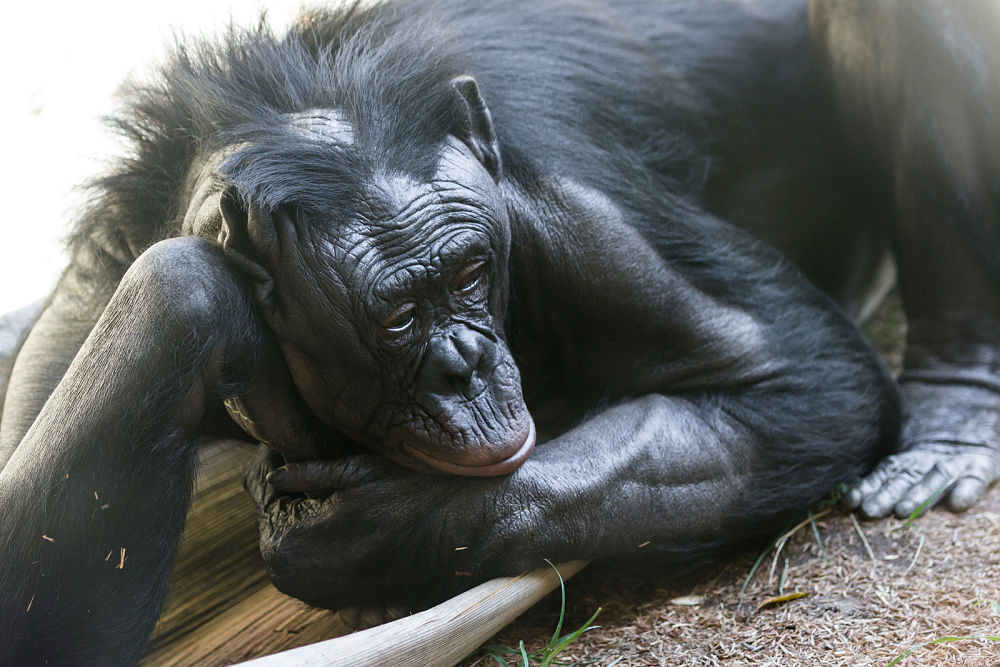 thoughtful bonobo
thoughtful bonoboChimpanzees and bonobos are two different species that separated about a million years ago when the Congo river was formed, geographically splitting the population. Even now the Congo prevents contact between chimps and bonobos in the wild.
The environment north of the Congo is more challenging, and chimpanzees have devised strategies to cope. Tool use and tool making among chimps is widespread, very common, and is cultural in nature. Adults will demonstrate the use of a tool to youngsters, and different troops may have different techniques in using the same tool, or may use different tools for similar tasks.
Chimps fashion sticks to use in catching termites, throw rocks, and amazingly have even been observed sharpening the ends of broken branches with their teeth, and using them to spear prey.
Bonobos in the wild have demonstrated very limited tool use, and little if any tool making. They have been observed using twigs as toothpicks, making rainhats out of leaves and branches, and using moss as a sponge to soak up liquid.
Many of these skills were created out of necessity, and the bonobos lush, rainforest environment may simply not warrant a multitude of inventions.
In captivity, both species show high levels of capability when it comes to manipulating objects and using tools that have been demonstrated to them, even using computers, building campfires and playing video games.
Another indication of intelligence is the kind of play that animals engage in. Here, the bonobos rule. They are far more playful than chimps, and remain so into adulthood, with adults regularly playing with other adults. Adult chimps don't play anywhere near as much as adult bonobos, and if they do, it is at the insistence of a juvenile.
Bonobos are extremely expressive and will engage eachother with direct gazes that precede incidence of play and also sex, sort of like, "are you thinking what I'm thinking?".
This isn't surprising when you consider that their brains show patterns of neuron activity called VENs, or spindle neurons, that are only found in significant numbers in four other animals - whales, dolphins, humans and elephants - the creatures considered to have advanced emotional capacity, and in particular, empathy for one another.
There is no clear answer to the question of whether bonobos are smarter than chimps, but it is clear that they are markedly different mentally and emotionally, and both are simply brilliant in their own ways.
- Amazing Bonobo Facts!
bonobo reproduction
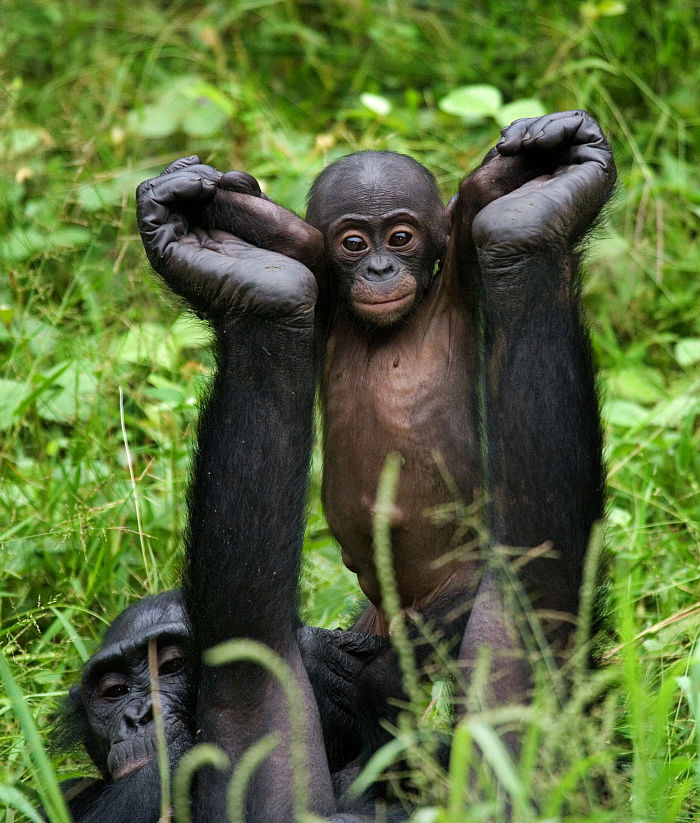
While most female animals are sexually active only seasonally, including their cousins the chimpanzees, female bonobos may engage in copulation with males at any time. There is virtually no competition between males, and no pair bonding. Either sex may initiate sexual activity. Nearly 30% of intercourse occurred with females who were not ovulating, and 30% of intercourse occurs face to face, with mutual gazing, and even French kissing .
Young female bonobos will leave their birth troop at about the time of their first monthly menstrual cycle, usually around 9 or 10 years old. They will join a new troop and gain acceptance from the dominant females through grooming, play, and sexual contact.
The first pregnancy is usually at about 13 or 14, and bearing her first infant will raise the young females social standing within the troop. Pregnancy lasts 8 months, and a single 2 to 3 pound infant is born well-furred with eyes open.
Bonobo infants develop more slowly than baby chimps. They do not leave their mother for the first three months of life, clinging tightly to her with hands and feet while being held against her chest.
It takes a full three years for the youngster to wander more than 30 feet away, and by that age they are riding on her back. Mothers and babies spend lots of time in little groups together, and baby bonobos play constantly with eachother. These are extraordinarily active, joyful little youngsters with a variety of games played both with eachother and with the adults in the troop.
Baby bonobos live on breast milk for the first year or so, and then begin to sample a variety of foods. They are not fully weaned until 4 or 5 years old, and may sleep with and travel with their mother for several years after that, occasionally assisting in the raising of a new sibling.
Young males will stay with the troop they were born into, will stay relatively close to their mothers throughout their lives, and will benefit from her high social ranking. Young females leave their mothers and their troop at about 9 years of age to join another troop, but may recognize and briefly socialize with their mother if they run into eachother.
Adult male bonobos do not contribute to the care of youngsters, and because there is no clear bonding, and no way of knowing which are their offspring, they are prone to indifference. At the same time, they are amenable towards youngsters, playful, casually affectionate and will protect them from predators.
Unlike male chimps who can be quite violent towards infants and juveniles, male bonobos rarely exhibit any aggression towards youngsters, and infanticide among bonobos has never been observed.- Bonobo Facts
a few more bonobo facts
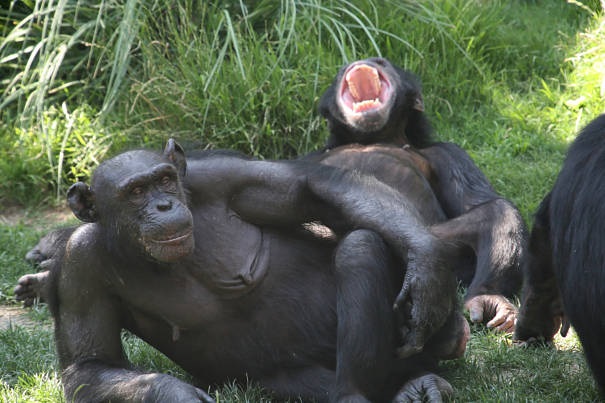
- A group of bonobos is called a "troop" or a "community"
- The bonobo and the chimpanzee are our closest living relatives sharing 98.7% of our DNA
- Bonobos have opposable thumbs and opposable big toes too
- The bonobo was originally called the "pygmy chimpanzee"
- The bonobo is probably the sexiest animal on Earth
- Bonobos have sex face to face and French kiss
- The bonobo was one of the last large mammals to be discovered in the wild
- Bonobos and chimps were once thought to be the same animal
- Bonobos were recognized as a separate species in 1929
Scientific Classification:
| Bonobo Facts - animalstats - | |||
|---|---|---|---|
| MALE | FEMALE | YOUNG | SOCIAL UNIT |
| male | female | infant, baby | group |
| GROUP | HOME | HABITAT | FAVORITE FOOD |
| troop, community |
Africa | jungle, rainforest | fruit |
| ENEMIES | ENDANGERED | TOP SPEED | LIFESPAN |
| leopard,human | yes | 28 mph | 40-50 years |
| GENDER DIFFERENCE | DIFFERENCE FROM CHIMP |
AVG..HEIGHT | AVG. WEIGHT |
| Males 15% larger | face is usually black |
Male -
3.5 feet Female-3 feet |
M- 75-120 lbs F- 60-80 lbs |
| ESTRUS | GESTATION | BIRTH HEIGHT | BIRTH WEIGHT |
| 1 x 35 days | 8 months | 9 inches | 2.5 lbs |
| RAISED BY | # OF YOUNG | AT BIRTH | EYES OPEN |
| mother | 1 | fine hair | at birth |
| EXPLORES | WEANED | INDEPENDENT | MATURITY |
| 8 months | 4 - 5 years | 7 - 9 years | 10 - 12 years |
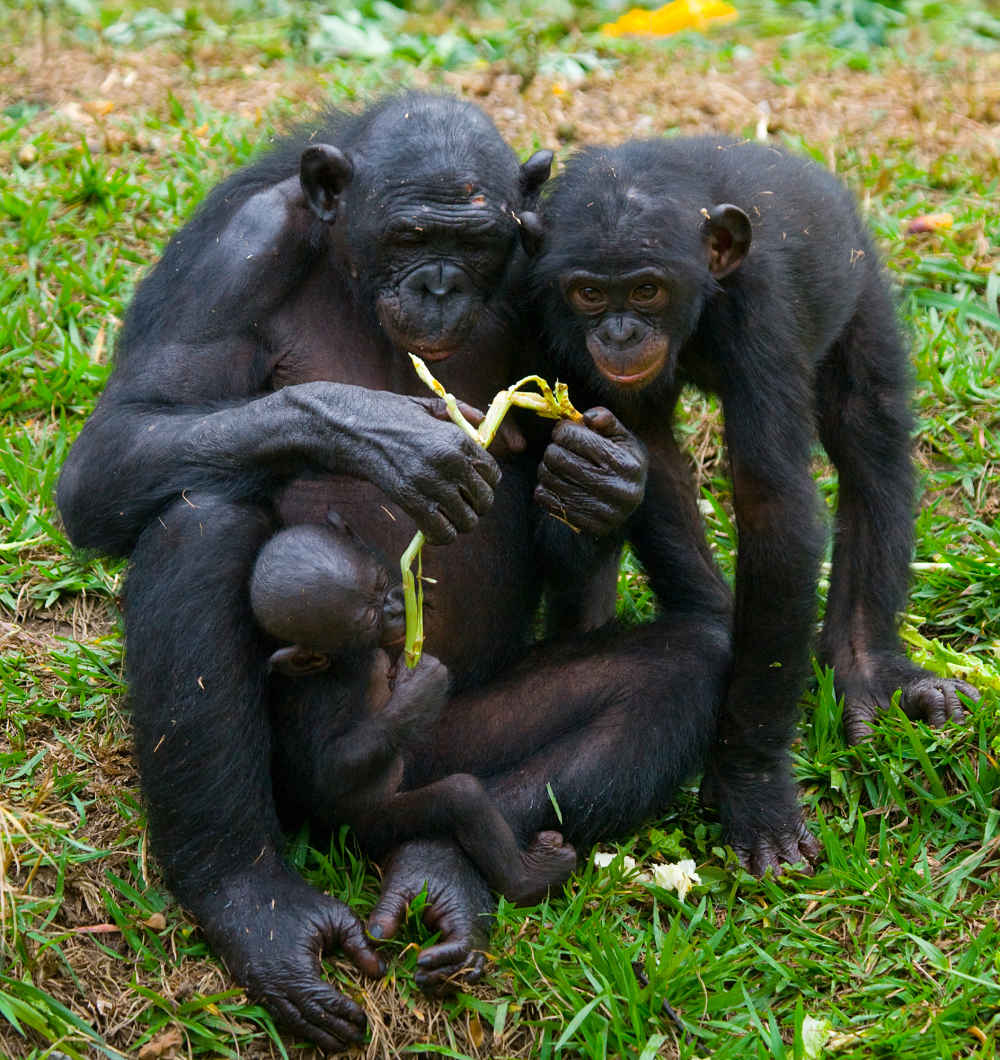
see more animal extreme closeups
Recent Articles
-
African Animals - Animal Facts Encyclopedia
Oct 11, 16 10:27 PM
African Animals facts photos and videos..Africa is a wonderland for animal lovers, and a schoolroom for anyone who wants to learn about nature, beauty and the rhythm of life -
Baboon Facts - Animal Facts Encyclopedia
Oct 11, 16 10:26 PM
Baboon facts, photos, videos and information - Baboons are very distinctive looking monkeys with long, dog-like snouts and close set eyes. -
Great Apes Facts - Animal Facts Encyclopedia
Oct 11, 16 10:25 PM
Great apes facts, photos and videos..Human beings did not evolve from chimpanzees, modern chimps and gorillas do not appear in the fossil records until much more recently than homo sapiens..




















